What-if… RAAF Dassault Rafale
This article is part of a series:
Subject
This is the second in a series of ‘what if' aircraft that I'm building.
In 1999 the Australian Department of Defence announced Project AIR 6000 "New Air Combat Capability (NACC)", which was intended to find a replacement for the air combat capability provided by both the 71 F/A-18A/B and 35 F-111C/G then in service. The F/A-18 provided air combat, strike and close air support capabilities, while the F-111 provided long range strike, reconnaissance and maritime strike capabilities to the RAAF. AIR 6000 sought to find a single platform that was able to undertake all of these missions.
Expressions of interest were sought from major aircraft manufacturers in Europe and the US and an eventual 9 contenders were under consideration. Alphabetically, these were:
- Boeing F/A-18E/F Super Hornet
- Boeing F-15E Strike Eagle
- Dassault Rafale
- Eurofighter Typhoon
- Lockheed Martin F-16E/F Desert Falcon
- Lockheed Martin F-22 Raptor
- Lockheed Martin F-35 Lightning II
- SAAB JAS-39 Gripen
- Sukhoi Su-27/30/35 Flanker
In June 2002 Australia joined the Joint Strike Fighter (JSF) development program and announced that the Lockheed Martin F-35 would be the solution to AIR 6000, provided that the final design met the RAAF needs and budget.
In the mid 2000's I decided I would build all of these "AIR 6000" jets and this is the second one I've completed. It is my interpretation of what a RAAF Rafale might have looked like, had it been chosen instead of the F-35A.
In my personal ranking, I put the Rafale as fourth out of the nine contenders. The Dassault Rafale has been designed to replace a number of specialised platform types undertaking range of roles for the Arme de l'Air (French Air Force) and Marine Nationale (French Navy). Therefore, the Rafale is capable of undertaking air supremacy, interdiction, aerial reconnaissance, ground support, in-depth strike, anti-ship strike and nuclear deterrence missions and it is for this reason that Dassault refer to it as an 'omnirole' aircraft. With the exception of the nuclear deterrence mission, these roles are a good match the requirements of the RAAF.
While the Rafale is a capable aircraft across all of the above roles and is able to carry three large external fuel tanks, it was not able to match the combat range of the F-111 that it was required to replace. I suspect it was for this reason that Dassault developed the Conformal Fuel Tanks (CFT).
For me, the Rafale is the most beautiful of the modern generation of jets, even with the CFTs fitted.
ADF aircraft are assigned a serial number starting with the prefix "A", then a type number followed by an individual aircraft number. I decided, for no particular reason, that the Rafale should be allocated A37, and, as I rank this aircraft as fourth, the full serial is A37-004.
3 SQN RAAF was established on 29th August 1916, at Point Cook, Victoria. It shipped first to England and then to France to begin operations on the Western Front in the Savy-Araas area on 10 September 1917. Famously, two 3 Sqn RE8s fired upon Captain Baron Manfred von Richthofen in the engagement that ultimately led to his demise. Crashing near the 3 Sqn base, an off-duty 3 Sqn pilot, Lt. James Lee Smith, DFC, led the retrieval party that recovered and later buried his body with full military honours. It was this service in France that led to the official squadron badge featuring a winged flaming grenade, emblazoned with a French Fleur-de-Lis (Heraldic Lily).
The squadron was disbanded in July 1919 and has re-formed and disbanded several times since.
During World War II, 3 Sqn served in the North Africa and Italian campaigns flying Gladiators, Hurricanes, Tomahawks, Kittyhawks and Mustangs. Famously, the Kittyhawks and Mustangs sported pale blue rudders with a white Southern Cross that persisted, in one form or another, as a squadron tail marking to this day.
Disbanded again in 1946, it re-formed as a fighter squadron in 1956 as the first CA-27 Sabre squadron (Australian manufactured version of the F-86F). From 9 November 1958 to 15 February 1967 3 Sqn was based at Butterworth, Malaya, taking part in the final stages of the Malaya Emergency (1948 – 60) and the Malaysia – Indonesia Confrontation (1963 – 66).
In 1967 3 Sqn returned to Williamtown, New South Wales, and converted to the Dassault Mirage IIIO. The squadron returned to Butterworth in 1969 only to return to Williamtown in 1986 to be the first operational squadron to convert to the F/A-18 Hornet. It has been based at Williamtown ever since.
In 2016 the squadron participated in operations over Iraq and Syria.
In another first, the squadron introduced the F-35A to operational service in 2018.
Due to the historical link with France, I decided my Rafale should belong to 3 SQN.
Construction
This kit dates back to 2000 and I must have bought it soon after that and probably started building it not long afterwards. After a long pause while we renovated our house, and other bits of life that pop up, I decided that this would be my entry in my clubs annual "Gunna Build" for 2019. The rules allow for kits to be less than 50% complete when entering, so it didn't matter that I'd already started it. I manage to get the kit 95% complete for the November judging and it has take me 'til now to get the last 5% done.
The fit of the kit is mostly very good except for the nose wheel bay insert, which required blending with putty and the engine intakes. The transition to the underside of the fuselage is badly mismatched and I had to do a bit of shaping, filling and sanding to get it right.
There is also no intake trunking. I was originally planning to mould some intake covers using white glue soaked tissue paper, but I couldn't get the shape right. So, I made some intake plugs using some stock plastic sheet and a corner piece of the kit sprue as can be seen in the pictures below.
I wanted to build a fully loaded and fuelled up aircraft so I acquired some Wolfpack Conformal Fuel Tanks (WP8033)). I also added the Wolfpack Rafale B/M Standard F2 set (WP48034) which included a new and more detailed radome and rear fuselage countermeasure dispensers, among other things.
Unfortunately Wolfpack messed up the radome by having the radar too far forward, to I had to clean off and fill all the detail, which was particularly annoying as I had just cut off the perfectly good kit radome to fit theirs on. I ended up using monofilament fly-fishing line to represent the lightning protector strips that I had to remove from the Wolfpack radome because they were too far forward.
Also in the upgrade are shorter wingtip missile pylons, but I decided to modify the kit parts instead.
Way back when I started this kit I inquired through my local hobby shop about buying extra parts I wanted. The local distributor was very generous in sending me an extra 2000 l fuel tank and MICA missiles from the Rafale B kit and the fuselage missile pylons from the Rafale M kit for free. So, now I had three of the large 2000 l fuel tanks. Detail was added to the lower valve on the drop tanks by gluing on thin circular slices of hollow tubing. The drop tanks were pinned to the pylons using copper wire.
I scratch built a pair of Meteors using the AMRAAMs from the Revell Eurofighter Typhoon and basing them on the Meteors from the same kit. Looking at pictures, it is evident that the Meteor fuselage pylons are shorter than the MICA fuselage pylons that I'd been given, so I cut a section out of the middle of these, joined them together and attached them to the fuselage. Then I drilled two matching sets of holes in the pylons and the missiles, inserted two short sections of copper wire and mounted the Meteors. Prior to mounting them I painted them Light Aircraft Gray (BSC381C/627) and then masked them for the two brown and one yellow live ordinance bands.
The kit MICA EM missiles were assembled and painted Light Aircraft Gray. Pictures show that there are several black and metal bands around the missile, plus the brown and yellow live ordinance bands and these were hand painted as they were too hard to mask. The missiles were mounted on the kit supplied missile rails. However, as I placed these at the extreme out-board wing locations I had to shorten the pylon by 5 or 6 mm and drill an pin them back together.
I intended to put MICA IRs on the wingtips using the extra missile bodies I'd been given and the seekers from the Wolfpack set, but the latter had very delicate fins that were broken off in some cases. Having read that Dassault had considered integrating AIM-132 ASRAAMs onto the aircraft if customers requested it, I decided to buy and fit some Eduard ASRAAMs, again pinning them using copper wire. These too were painted Light Aircraft Gray and the Eduard supplied decals applied. In the process I lost one of the ASRAAM control surfaces to the carpet monster so had to scratch a replacement which then broke when I was mounting the missile on the jet and had to be repaired.
The final pieces of ordinance were the SCALP EG missiles. The kit supplied missiles needed a bit of work to remove seam and sink marks, but the plastic was a little hard to work with. Instead, I stole the Storm Shadows from the Revell Eurofighter Typhoon kit as these were better shaped and the plastic was softer. For a bit of variety I painted these Gunze Dark Gray (2), which is a slightly greenish colour. The decals from the Typhoon kit were used.
Camouflage and Markings
Camouflage is Extra Dark Sea Grey over Medium Sea Grey.
The 3 Squadron marking on the tail came from the Kinetic Hornet kit. The diving eagle carrying a bomb was a bit too like the dark grey so I over-painted it with a light grey. The white southern cross is also from the Kinetic kit. The roundels and serial numbers are from Aussie Decals.
The final touches were completed on 19/09/2020, making this a roughly 18-year project.
This is another kit that spent a long time on the shelf before I picked it up again and completed it. I'm glad I got energised again and I'm very happy with the way it turned out, particularly the camouflage scheme.
I have seven more ‘what-if' jets to build.
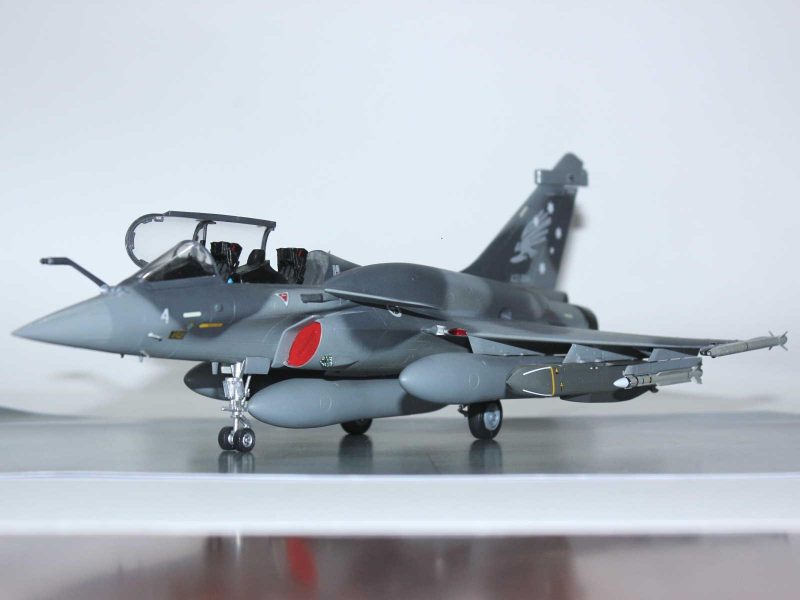










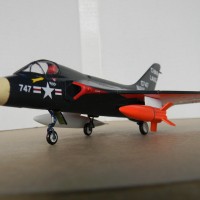
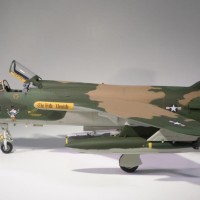
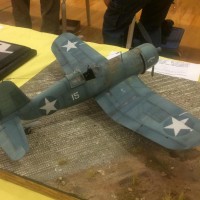
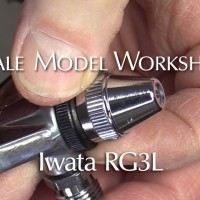
That’s a beautifully built model. Awesome painting.
I hope the F-35 proves to be a great fighter.
You mean the Brewster Buffalo of 2020?
Thanks, Jay.
This is a wonderful model, Michael!
I loved the historical background of the 3 SQN, as well as the detailed build description.
Hellenic Air Force recently decided to buy Rafales. This makes your build even more interesting to me!
G'day Spiros (@fiveten),
Thanks.
I had heard that you were getting Rafales.
Now you'll need to build one too.
I will for sure, @michaelt!
@fiveten I'd love to have an excuse to do an Aegean Ghost Rafale!
I wish we would have our Rafales delivered in Aegean Ghost, @gkittinger!
Or even in the lovely two tone M2000 grey/blue scheme.
However, I 'fear" that the now so common blant grey allover might be a strong candidate...
Who knows? Miracles happen!
In the meantime, why not building an Aegean Ghost Rafale, as a camo demostrator, prior to the Greek Rafale contract finalization?
How about that?
G'day Spiros (@fiveten),
I've just looked up the Aegean Ghost scheme - I love a 3 tone camouflage.
I also like the Mirage 2000 grey/blue scheme.
I originally intended to add a dark green "shadow" to the dark grey on my Rafale, but decided it would make the aircraft too dark. Maybe I should have used lighter colours to do that.
Still, I'm happy with the way things turned out - it follows the Rafale B01 aircraft scheme.
I might have to take inspiration from the Greek F-16s when I build my F-16 what-if.
Yep, your scheme follows that of Rafale B-01 and it is absolutely gorgeous, Michael @michaelt!
The ghost scheme was a "Greek" invention, heavily inspired by the US Top Gun agressor schemes. It's a lovely looking and very effective camo, its problem being the quick weathering, due to the matt nature of the paints.
To my understanding, the Rafale leans towards satin, at least at the first produced "prototype" examples.
Mmmmmm, an RAAF F-16 in ghost? I bet it would look marvellous!
Fantastic result, Michael.
Paint job and full load shows the beauty of this plane.
Thanks, john.
From a modeling stand point your efforts have payed of handsomely Michael. The photos show an attractive well done model.
Two thumbs up.
Thanks, Stephen.
I love "what if" builds. Great job on the build, and a good canvas for your creativity. Well done.
Thanks, George.
Great model and background story. Those conformal tanks give it a really different look. I think Tom might be correct with the "Buffalo" reference.
Thanks, Haslam.
Hello Michael,
Interesting contribution. Excellent replica of the Rafale. Would have been a good choice for the RAAF.
A fact is, that the Rafale is not a 5th generation fighter. But, personally I think, that for instance the Royal Netherlands Air force would have been better of with the French aircraft.
More aircraft for the same budget. Proven in combat. Excellent rating maintenance in relation to flight hours. Very versatile. Lots of internal space for future improvements. The opposing side would tell you, that the Rafale is already from a stone age as you would look into the drawing board and development years.
You did comment on the (short) range from the Rafale. But I was told that the range of the F-35 was a concern to the operational air warfare planners. I realize, we are speaking of different variants - A/B/C.
Thanks for your lengthy article. Much appreciated.
Regards,
Dirk - The Netherlands.
Thanks, Dirk.
Range is relative - no modern combat aircraft, large bomber types excepted, can match the range of the F-111 unrefueled.
I didn't know conformal tanks were available for the Rafale - presents a very "steroidy" looking bird! That's a great looking model.
Thanks Greg (@gkittinger),
Just about every modern jet has conformal tanks.
The F-15E was first, the latest F-16s have them (looking more like 1980's shoulder pads), the F/A-18F and EA-18G are getting them and the Eurofighter Typhoon has them too.
Great build and thread Michael thanks for adding your build link to my Rafale and I may be led into a RAF Rafale 😊